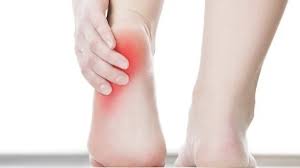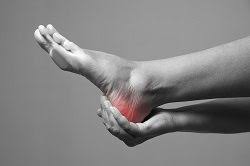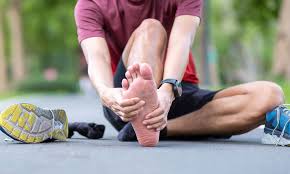Midfoot and Heel Conditions
Midfoot and heel conditions are issues we see very regularly at Hurst Podiatry Melbourne.
They can be complicated, complex and are often amongst the most painful and debilitating conditions that we look after.
Injuries to this part of the foot can impact our ability to work, play sport and even walk at all if they deteriorate far enough.


The midfoot and heel have a very important role to play during normal walking. They are responsible for absorbing initial impact from contact with the ground as well as for stabilising the foot as we move towards propulsion.
Here at Hurst Podiatry, we’re here to make sure your heel and/or midfoot are taken care of and functioning properly with our expert podiatry services.
Causes of midfoot and heel conditions
There are many possible reasons why you might be experiencing pain or discomfort in your midfoot or heel area.
Many people will comment that they have flat feet or high arches, which can be causes of this pain or discomfort.


Other common causes include ill-fitting footwear, standing or exercising on hard surfaces for long periods of time, illnesses, and injuries. And one of the most important factors that can cause heel or midfoot pain is the way your foot moves and functions and why.
Lots of muscles, joints and tendons need to be working together to ensure you can walk and move properly, which means there are lots of areas in the midfoot and rearfoot that can cause you pain.
Common Heel and Midfoot Conditions:
Some of the common midfoot and heel conditions we can offer solutions to are:
- Osteoarthritis
- Plantar fasciitis
- Adult acquired flat foot (tibialis posterior dysfunction)
- Pes Planus (flat feet)
- Pes Cavus (high arches)
- Achilles tendon injuries
- Heel spurs
- Midfoot sprains and fractures (Lisfranc injuries)
- Stress fractures
- Baxter’s nerve entrapments
- Haglund’s deformity
- Cuboid Syndrome
- Tarsal Tunnel syndrome
- Muscle tendinopathies
These are just some of the conditions that can affect your midfoot and/or heels.




How We Can Help You at Hurst Podiatry
Here at Hurst Podiatry, we’re experienced in the assessment, diagnosing and treatment of many conditions that can affect the feet and lower legs, including those that affect the midfoot and heel.
Our aim is to find out why you’re experiencing pain. Everyone’s feet are unique and deserve a unique solution.
We uncover what is hurting you then apply our years of experience to identify your why and apply a unique solution that suits you.
If you are experiencing pain in your forefoot or toes in Melbourne’s East, book in to see us here at Hurst Podiatry. Call 03 5901 2216 or book online here.
Frequently Asked Questions about Midfoot and Heel Conditions
-
What are the symptoms of midfoot and/or rearfoot problems?
This depends on the condition you are experiencing but some of the things you might begin to feel when you are suffering heel and ankle symptoms are
- Burning pain
- Dull aches
- Instability and weakness
- Loss of balance or rolled ankles
- Pain after periods of rest
- Cramping
- Worsening pain with activity or exercise
- Sharp shooting pains
- Stiffness and locking of joints
- Feeling like you are walking on a lump or stone
- Bruised feeling or actual bruising
-
How are heel conditions treated?
This will we be dictated by the condition you are experiencing some of the treatments that are used for routinely at out clinic for heel and ankle conditions are:
- Dry needling
- Shockwave treatment
- Moon boot therapy
- K laser therapy
- Footwear modification
- Orthotics
- Custom rehabilitation programs
- Manual conservative therapy
- Strapping and padding
- Braces
- Topical anti-inflammatories
- Hot and Cold therapy
-
My heel hurts first thing in the morning what could that be?
Whilst not the only possible cause of heel pain in the morning in your heels is a very common symptom of plantar fasciitis. When a patient come to our clinic and explains they’ve been experiencing these sort of symptoms. We do a full assessment to determine exactly what’s causing the pain. Whilst plantar fasciitis is probably the most common injury in that part of the foot the pain could also be due to an Achilles injury, retrocalcaneal bursitis, tibialis posterior dysfunction or an array of other muscle tendinopathies. As there are quite a few possibilities it is always a great idea to come and find out exactly what is happening so we can help you start to get better.
-
Do I need orthotics for plantar fasciitis?
Not always. Orthotics are potentially a wonderful treatment option for plantar fasciitis, but they are certainly not the only option. Orthotics are great if the cause of your plantar fasciitis is due largely to the shape of your foot and the way that you walk. This is certainly not the only cause though of plantar fasciitis though, by talking to you about your condition and how you got there we can help you work out whether or not orthotics is good option for you or not.
-
What can I do about Plantar fasciitis?
Lots! Common treatments for plantar fasciitis you can do at home include applying anti-inflammatory products like fisiocrem, using heat to encourage healing, wearing more supportive shoes, using a soft heel pad, and doing calf and arch stretches. These sort of simple therapies might be all you need to get things going in the right direction but if they fail, we regularly work with you to use treatment options like moon boots, shockwave therapy, K laser therapy, orthotics, footwear changes, exercise modification and custom exercise rehab programs to get you up and moving again.
-
My feet rolls/I have flat feet do I need to get them checked?
Pronation or rolling in is a perfectly normal movement during walking and on its own not something you need to worry about. If the movement is excessive or compromising the way you walk though it can begin to contribute to injuries. Overpronation has been linked to conditions like plantar fasciitis, MTSS, achilles tendinopathies and posterior tibialis tendon dysfunction. We can help you determine how much is too much if you’re not sure the safest thing is to ask, that’s what we’re for after all. We can help explain whether the way you’re walking or running is likely to be problematic and guide you to a solution if it is.
-
I have a heel spur, is that a problem?
Probably not. Many people have heel spurs, and it is a bit of misconception that they are a huge problem. It is possible if the spur fractures or gets large enough to interfere with surrounding anatomy that they become a problem but, in most cases, they exist without causing any problems. If you think they might be causing you can issue, or you just want to check we’re very happy to walk you through what can and needs to be done.
-
Do I need a referral to come to Hurst Podiatry?
No, a referral is not required to book in to see us here at Hurst Podiatry.
We’re available to patients of all ages, whether you’ve experienced an injury, you need help taking care of your feet, or you’re experiencing discomfort in your lower limbs, because everyone is welcome here at Hurst Podiatry.
We have 5 clinic locations in the Eastern suburbs of Melbourne, including in Healesville, Croydon, Kilsyth, and Mooroolbark.
Book today by calling us on (03) 5901 2216 or booking online here.
